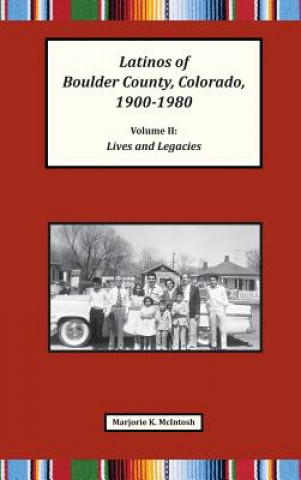
Livrare
Consilier de cumpărături





Nu se pretează? Nu contează! La noi puteți returna bunurile în 30 de zile
 Voucher cadou
orice valoare
Voucher cadou
orice valoare
Cu un voucher cadou nu veți da greș. În schimbul voucherului, destinatarul își poate alege orice din oferta noastră.
Latinos of Boulder County, Colorado, 1900-1980
 engleză
engleză
 54 b
54 b
30 de zile pentru retur bunuri
Ar putea de asemenea, să te intereseze


This book paints a vivid picture of how Latinos in Boulder County lived between 1900 and 1980. Based upon an unusually rich collection of interviews, family biographies, photos, and other personal sources, the study examines multiple aspects of the daily lives of local Latinos. Rather than being a formal sociological study, it presents the human experiences of individuals and families, often in their own words and through the photos they have preserved. The study is based on a unique collection of sources assembled by the Boulder County Latino History Project, a community-based initiative. In 2013-14, ten Latino interns (high school and college students) and 80 volunteers collected some 1,600 primary sources, which together make possible this account of Latino lives and the legacies they have left. This volume focuses on the same three towns as Volume One-Longmont, Lafayette, and Boulder-analyzing how social, cultural, and religious patterns within those towns varied. It offers interesting comparisons with Latinos living closer to the core of the Southwest borderlands or in the barrios of major cities. The book begins with a discussion of Latino families, including the importance of women, and the key stages and transitions in the course of life. It turns then to the generally poor housing in which many Latinos lived, initially on farms or mining camps but increasingly in towns. The urban neighborhoods in which they clustered were low-income but had a mixed population of Latinos and people from other backgrounds. The cultural importance of food is then discussed, along with how health care was provided within families and neighborhoods and how Latinos gradually entered into formal medical positions. Another chapter considers social life, entertainment, and sports, including the impact of segregation in many cultural and athletic settings until the mid-twentieth century. Religious activities are next. That chapter stresses the key roles of senior women during the first half of the century, when most religious instruction and prayer happened at home. Involvement in parish life came only later. The final chapter examines education, highlighting the Latino commitment to education, the discrimination children faced at school, and information about the numbers, ages, and grades of students over time. A captivating epilogue jumps 30 years forward to the experiences of the ten optimistic and committed young Latino interns who videographed many of the interviews or made films. We hear directly from them regarding their own lives and their own individual struggles. Some of the most moving stories come from those interns who are undocumented immigrants or the children of undocumented parents. The interns' accounts reflect many of the concerns and aspirations found among other young Latinas/os in the U.S. today. This study is ideally suited for use in school or college classes. Nearly all of the primary sources are available online and hundreds of URLs are provided, allowing students to view the raw material that underlies the historical account. A special section of the BCLHP's website (bocolatinohistory.colorado.edu) is for educators, containing Primary Source Sets, Lesson Plans, short clips from interviews and films, and other instructional materials. The quantitative appendices are useful teaching tools, as are the unique interactive, computer-based maps, one for each of the three towns in every decade between 1926 and 1975. Prepared by the BCLHP, they display the location of households headed by people with Latino surnames, allowing us to study changes in housing patterns and neighborhoods over time. Volume I in this set, History and Contributions, traces the experiences of Latinos across three periods: the early arrivals, 1900-1940; the transitions of 1940-1965; and the period of Chicano activism, 1966-198
Informații despre carte
 engleză
engleză




 Cum să cumpăr
Cum să cumpăr





















